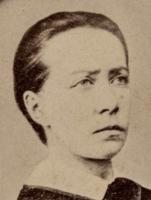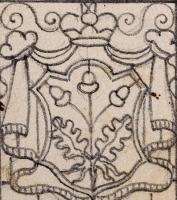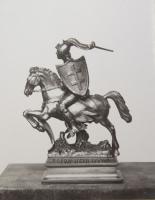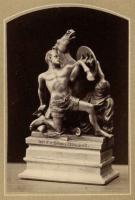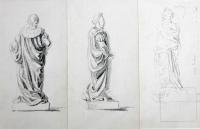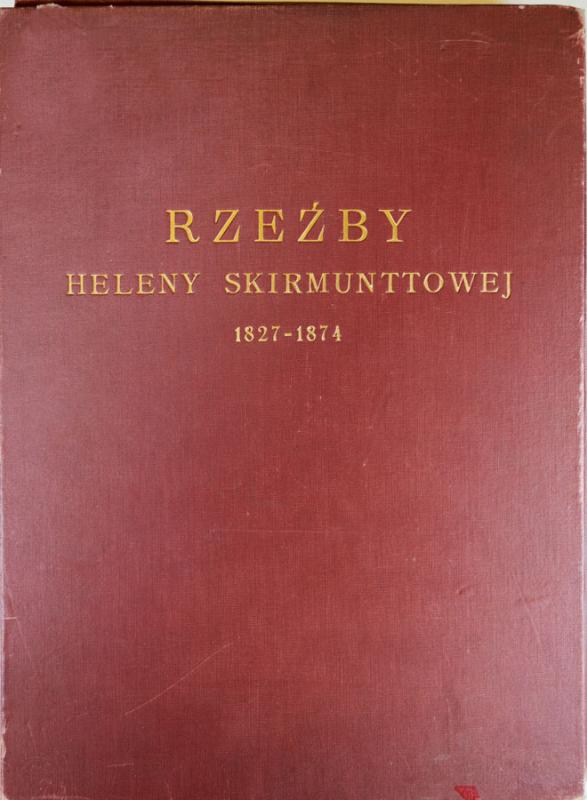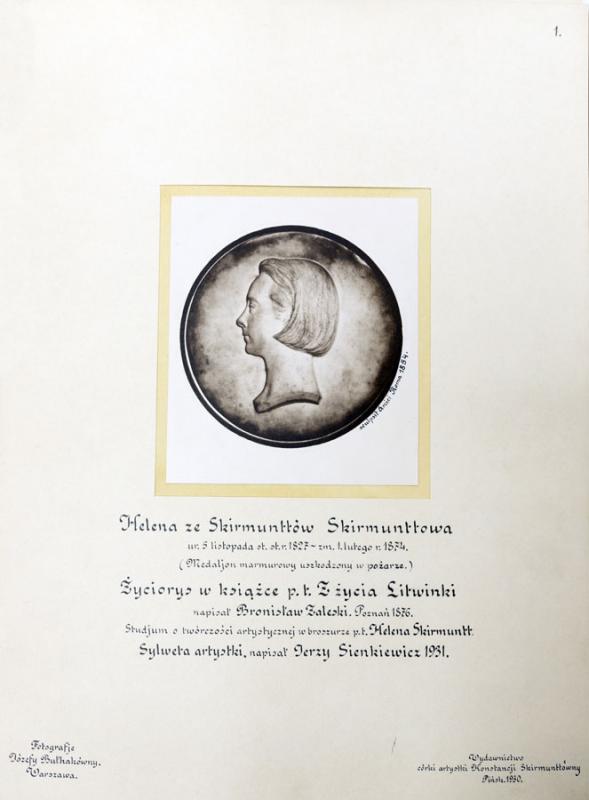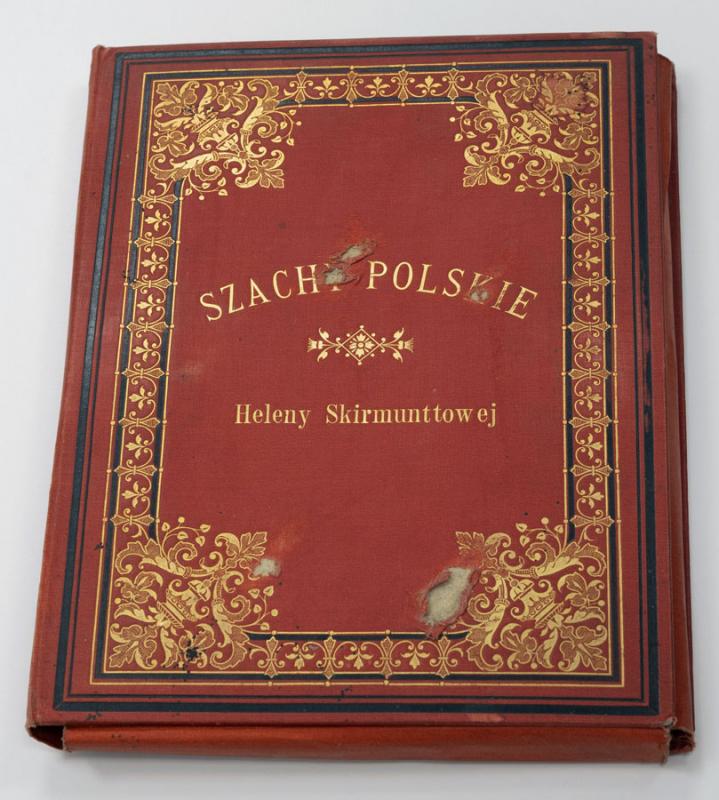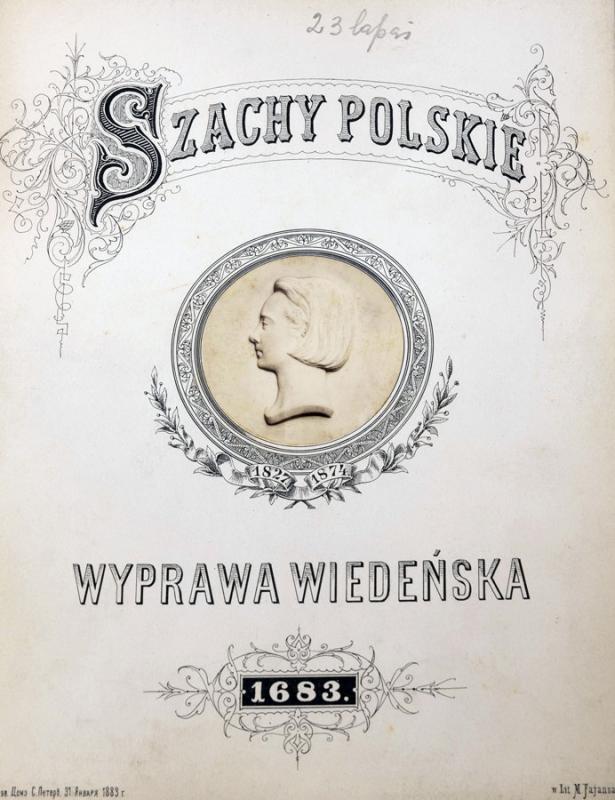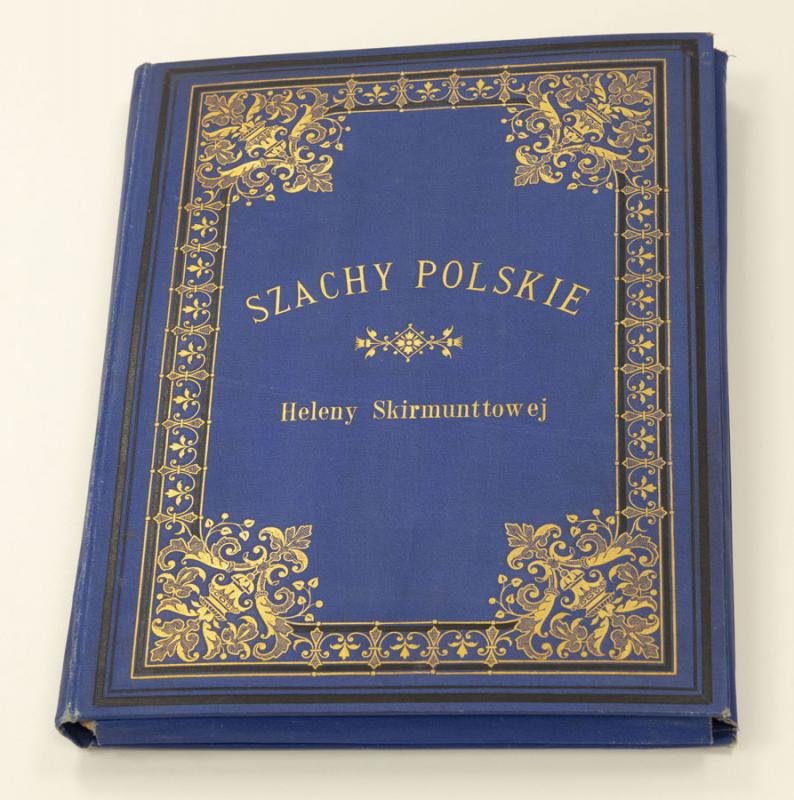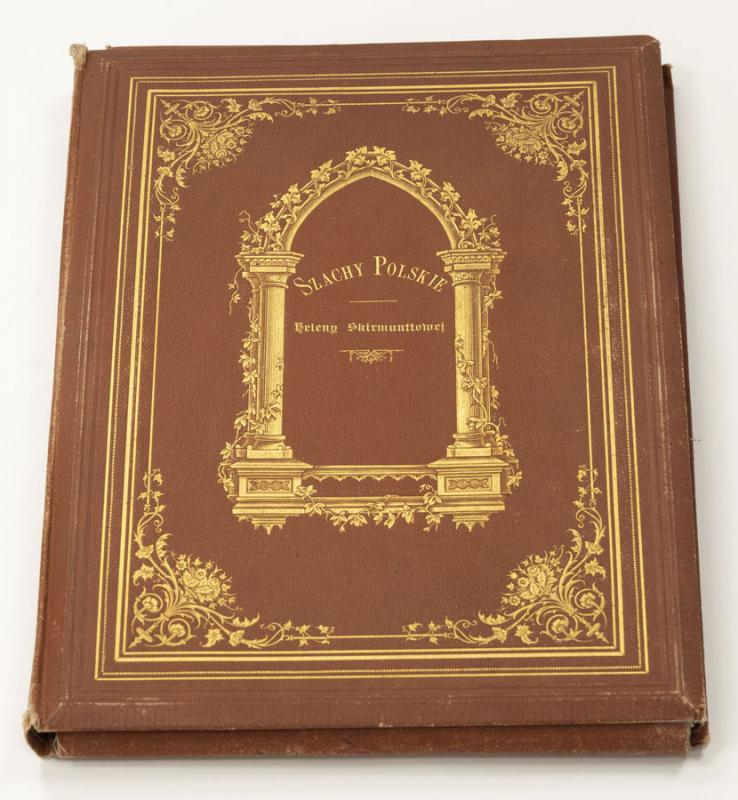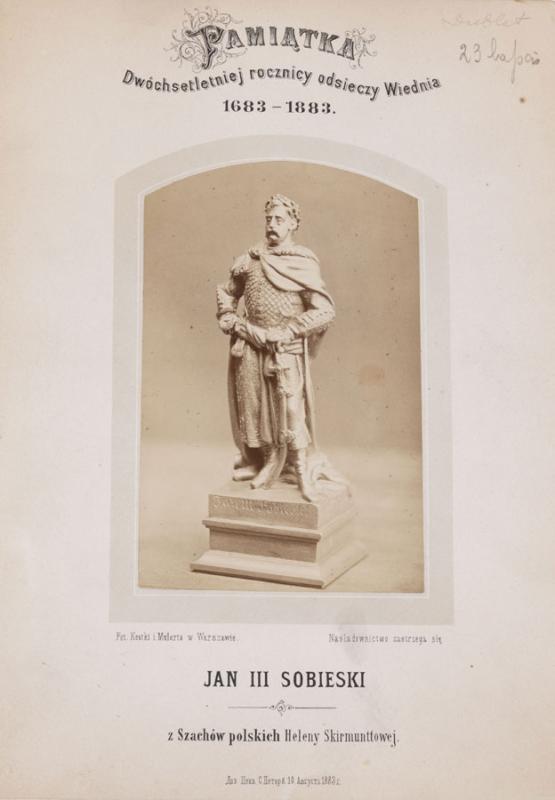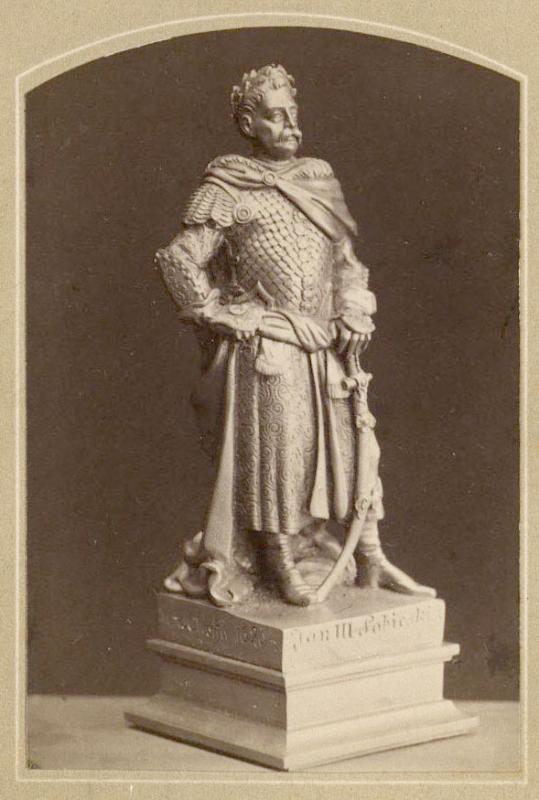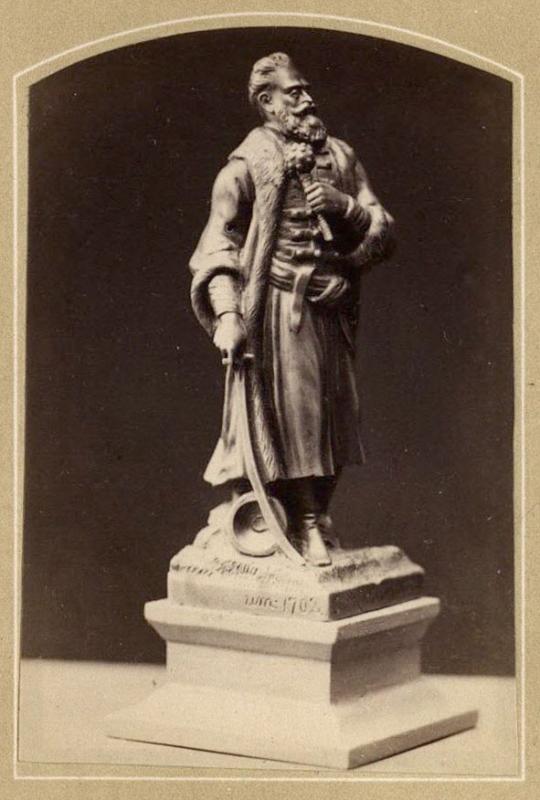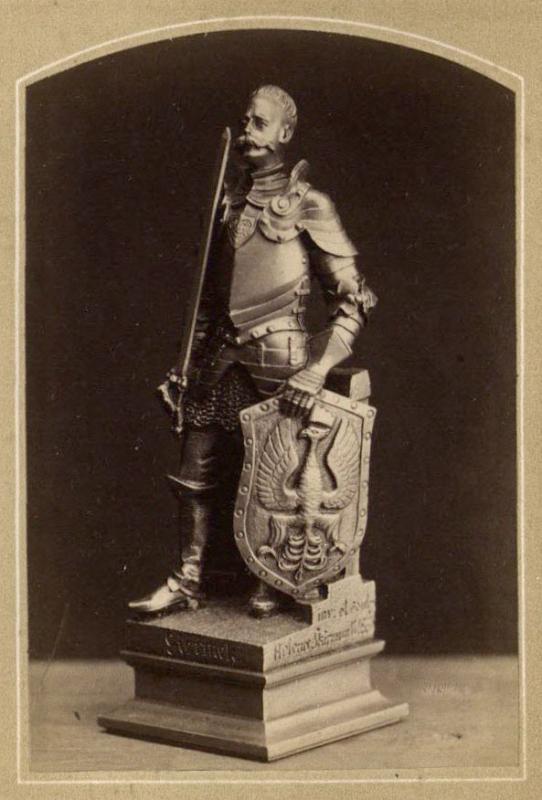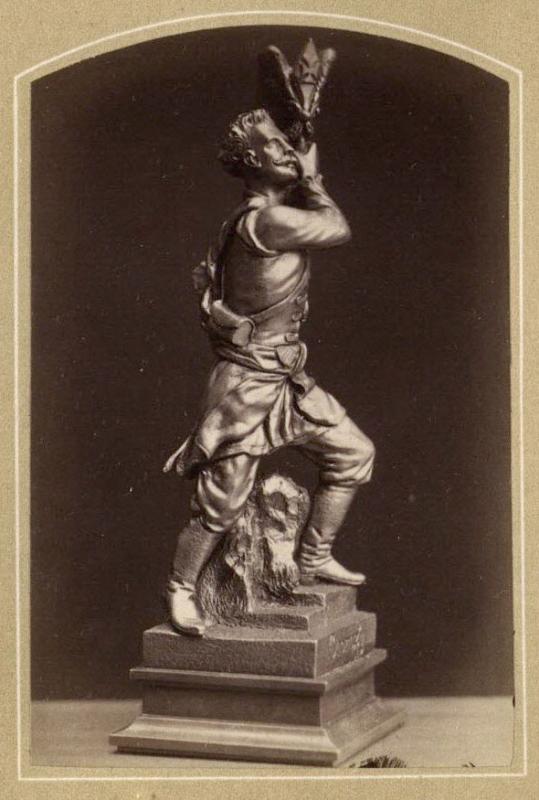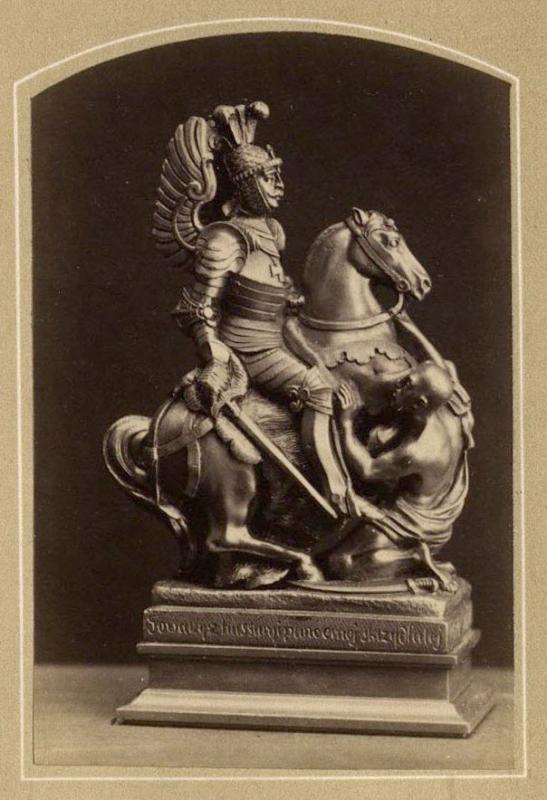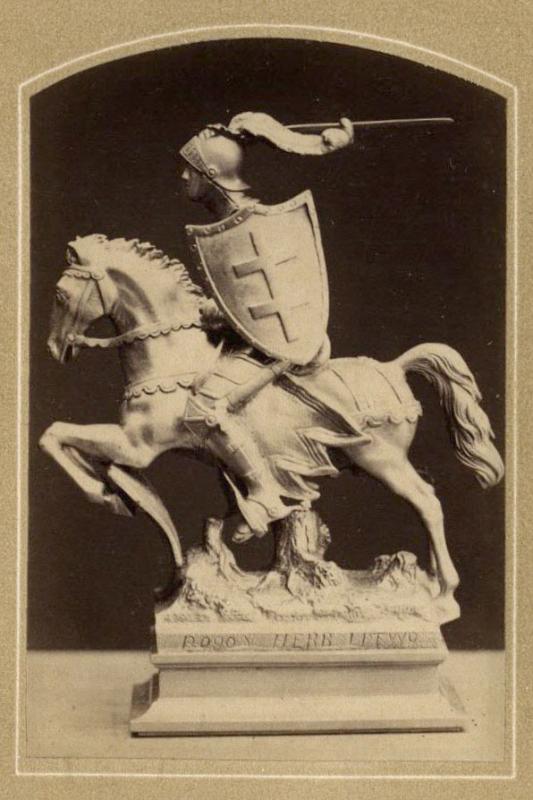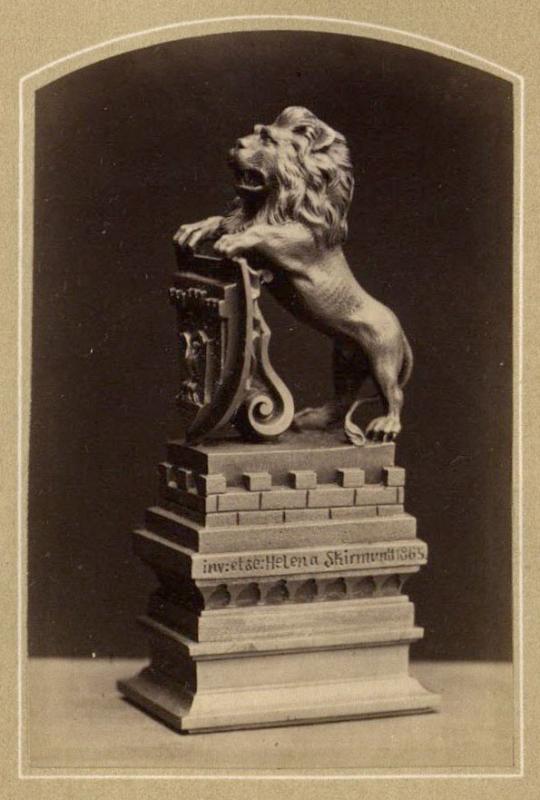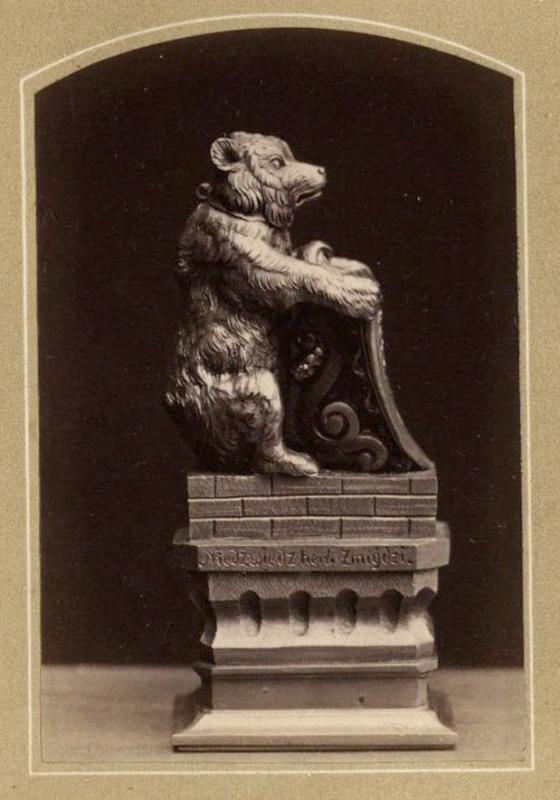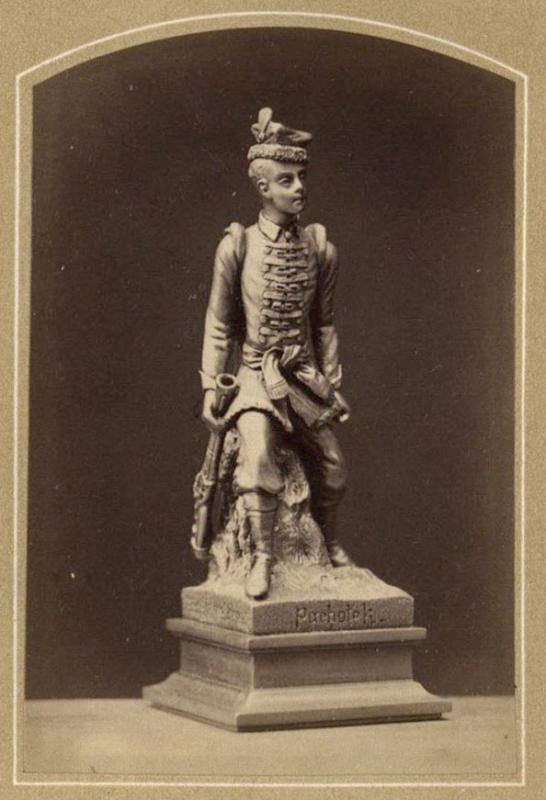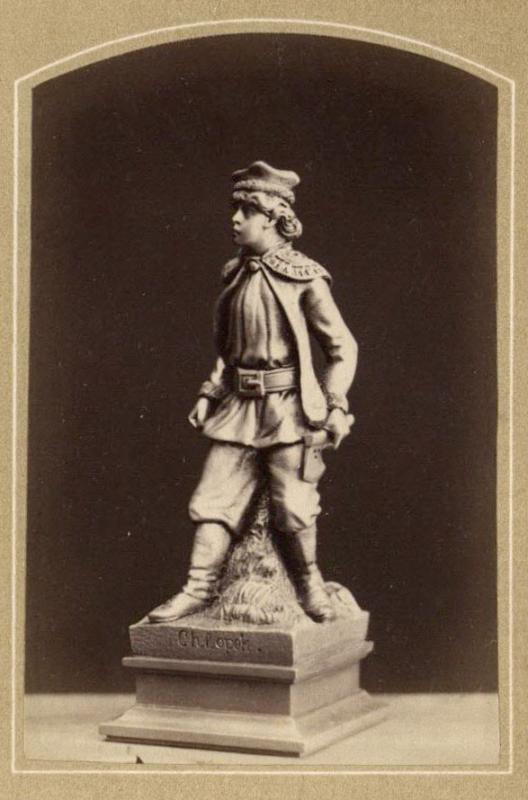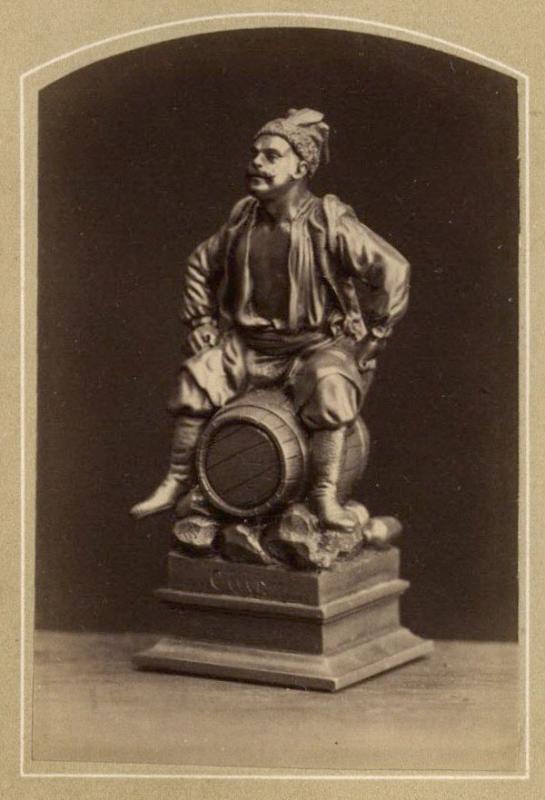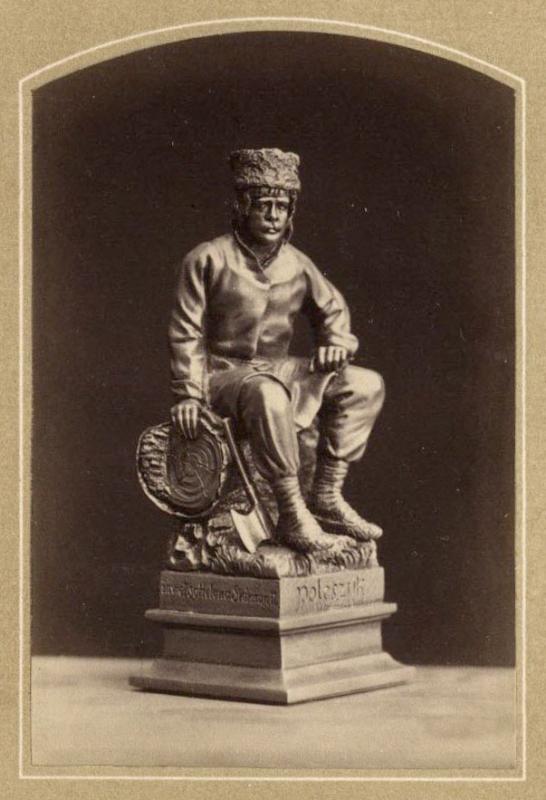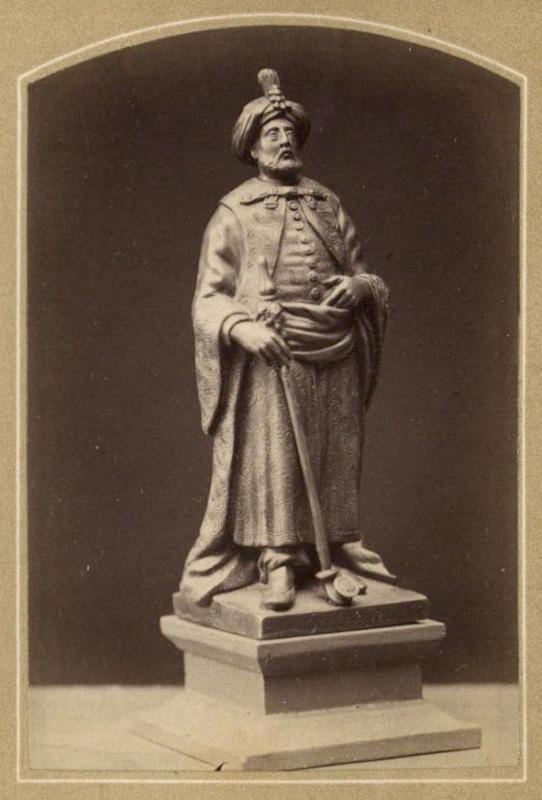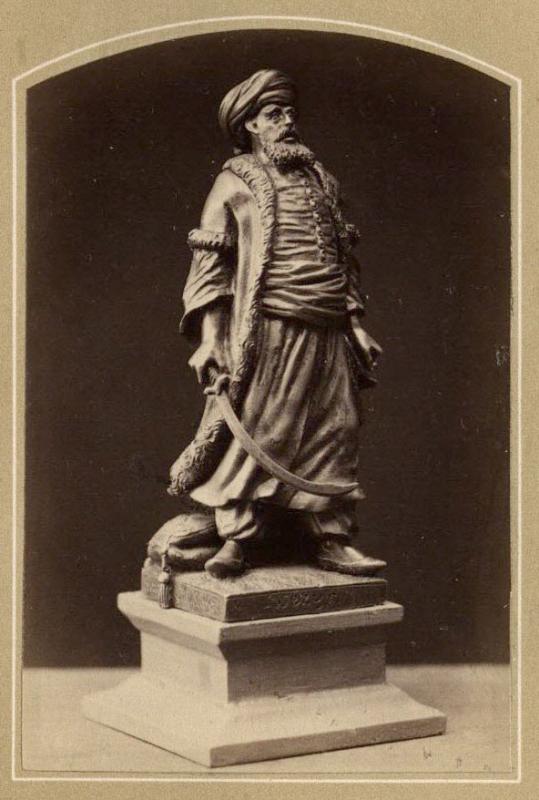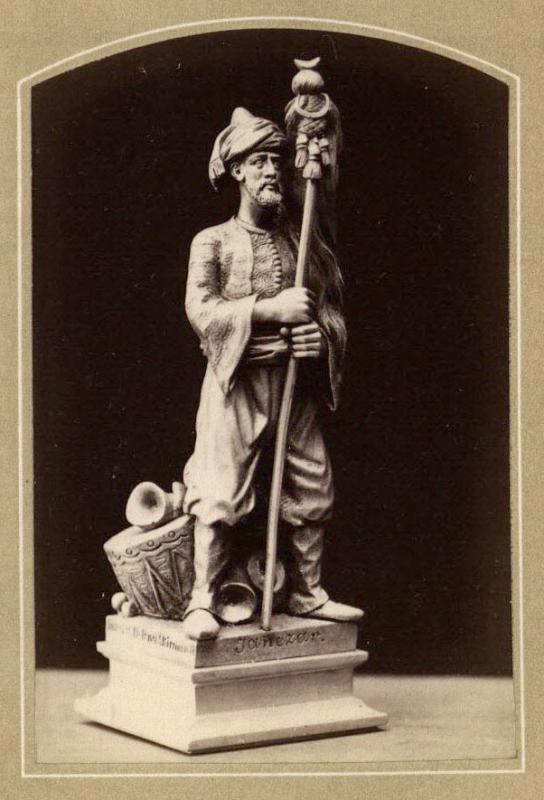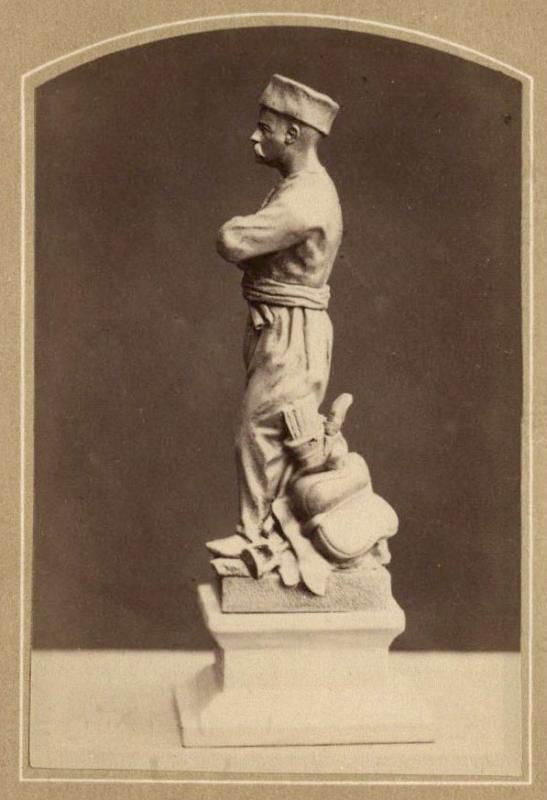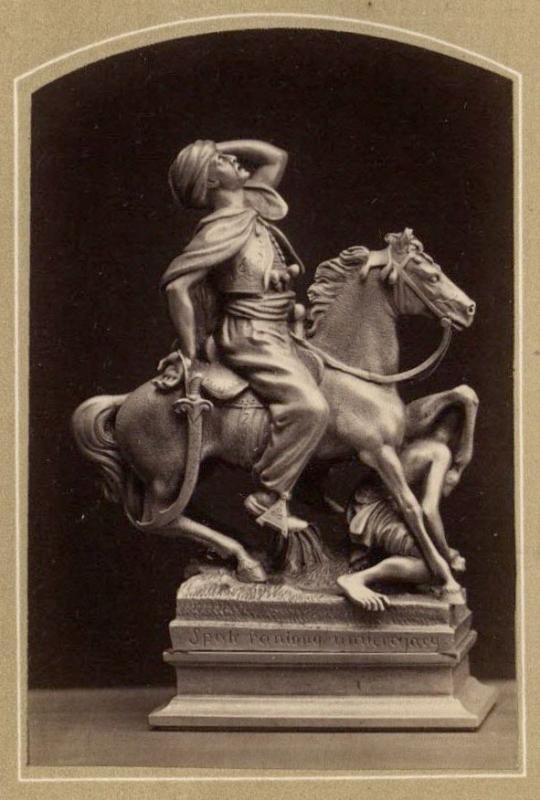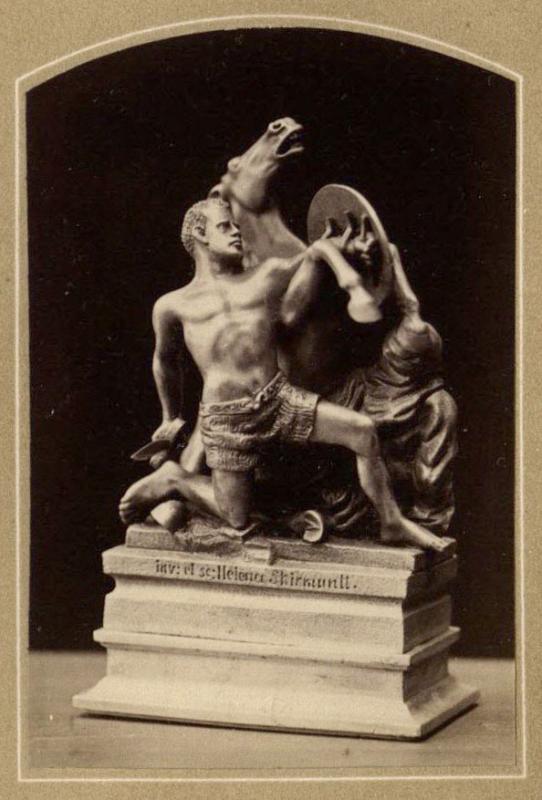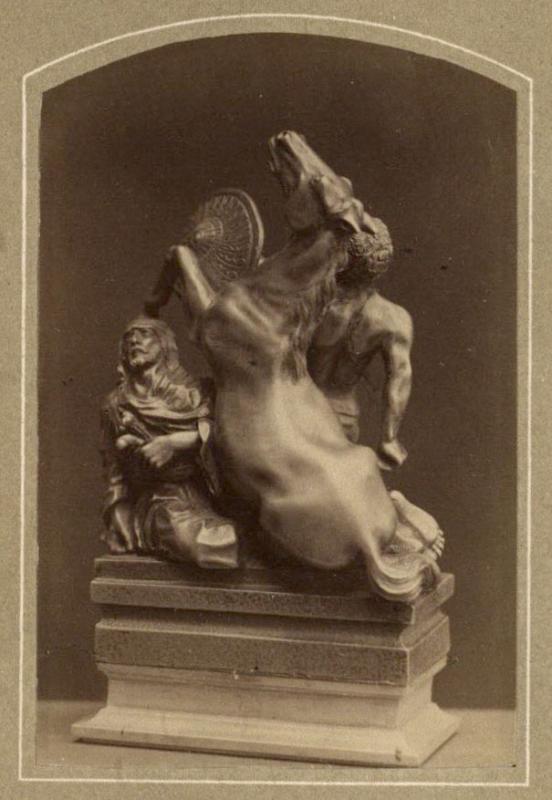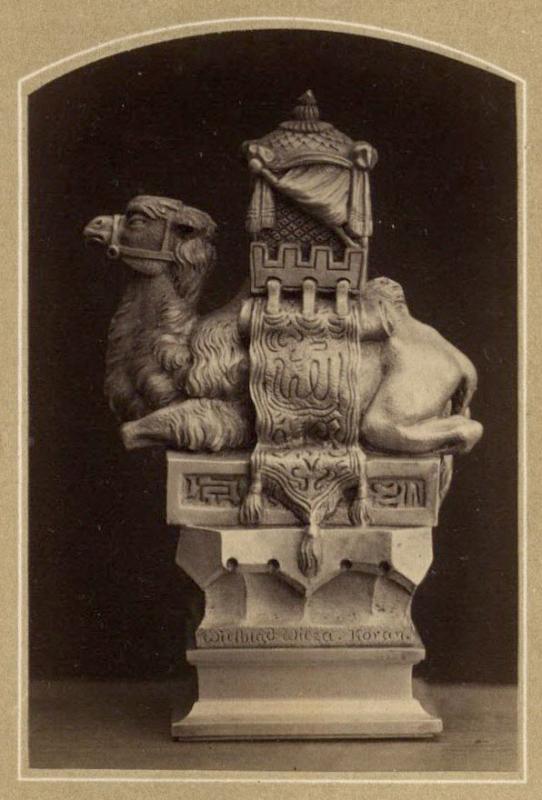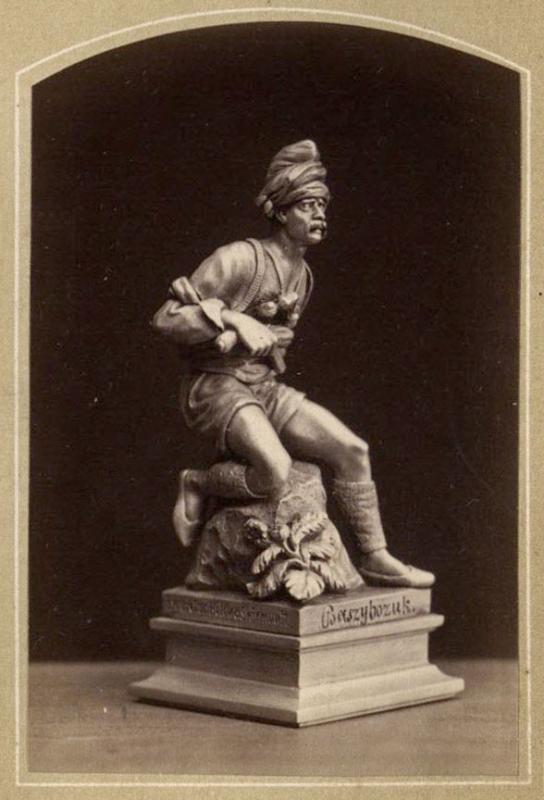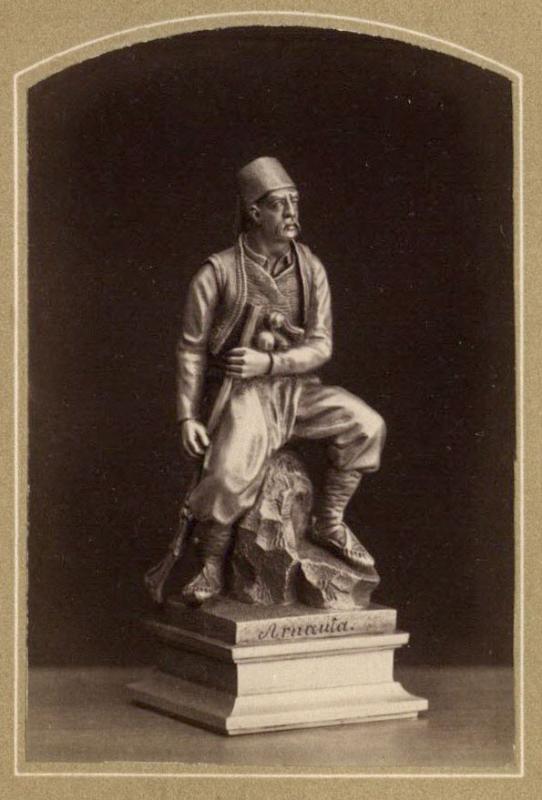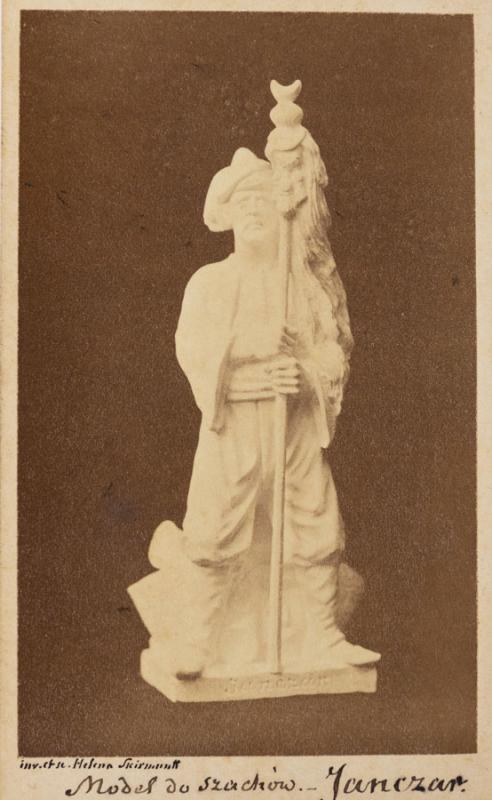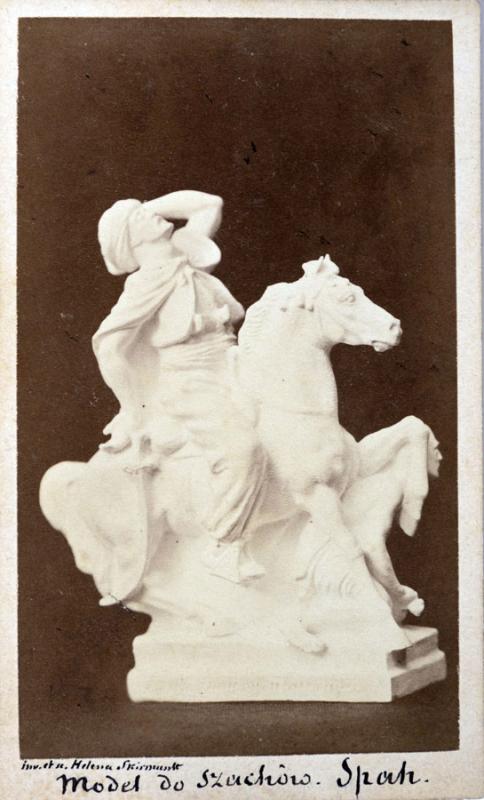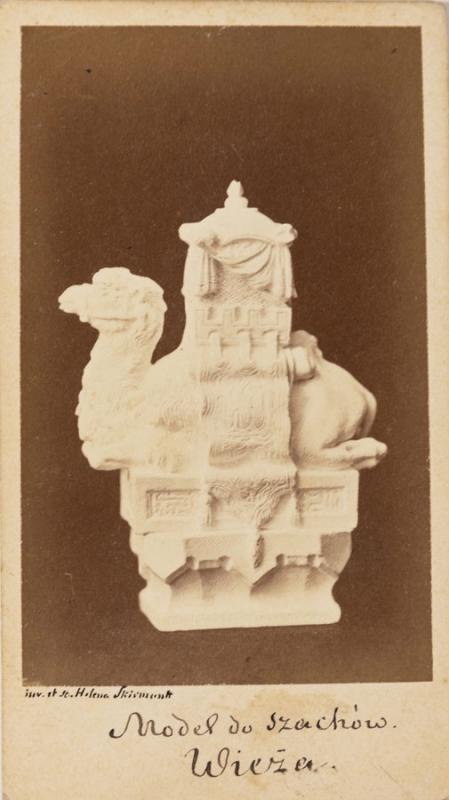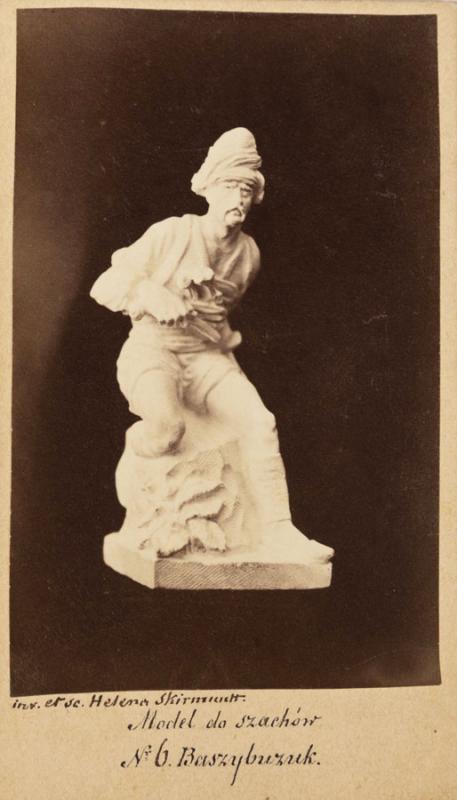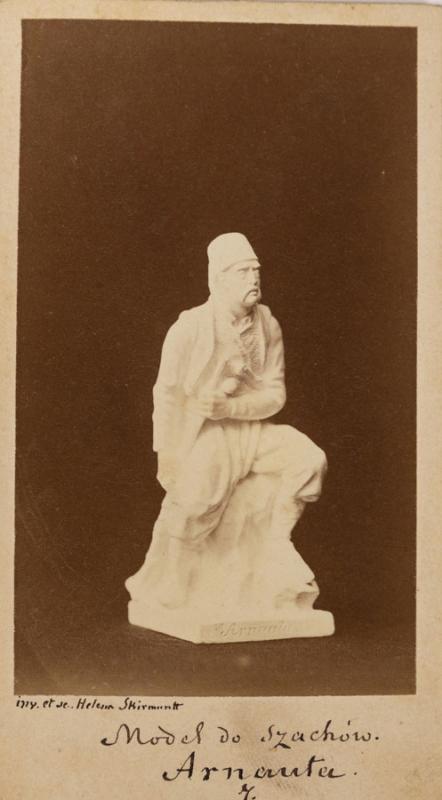Chess pieces in old photographs
The beginning of photography is thought to be January 7, 1839, when the French physicist Dominique-François-Jean Arago (1786–1853) announced in a meeting at the French Academy of Sciences the invention of Louis-Jacques-Mandé Daguerre (1787–1851), one of the pioneers of photography, the daguerreotype. At that time, Helena, the only child of the Skirmuntt family, was 11 years old and concentrating on drawing. It is likely that she learned about the invention not from newspapers, but from her uncle, the painter Napoleon Orda, who emigrated to Paris after the uprising of 1830–1831. After the improvement of technology in photography and the formation of a network of commercial photo studios, Helena began to value the advantages of photography. She used the opportunity to take a picture of herself (a fragment of a portrait photograph from 1857 has survived), and as soon as she started studying sculpture at the end of 1852 in Vienna, she began working on a medallion based on her husband's daguerreotype, and photographed examples of her work to discuss them with her correspondents. It is known that Helena repeatedly sent photographs of her chess pieces to friends, family and intellectual acquaintances. Her brother-in-law Konstanty Skirmuntt, her uncle Napoleon Orda, and historian Józef Ignacy Kraszewski (1812–1887) had received such photographs.
After Helena’s death, the photographs became very useful for research and distribution of her works. In 1876, Polish xylographers made engravings of all her chess pieces (except for the Bear and the Tatar) for the article of publicist Antoni Pietkiewicz (pseud. Adam Pług, 1823–1903) in the popular Warsaw magazine “Kłosy” (“Bills”). In 1883, photographers Julian Kostka and Ludwik Mulert collaborated with the lithographic studio of Maksymilian Fajans in Warsaw to publish a collection of high-quality photographs of the chess pieces, called “Szachy polskie: Wyprawa wiedeńska, 1683” (“Polish Chess Set: Vienna Campaign, 1683”). The collection was published in honor of the 200th anniversary of the Battle of Vienna. In the first decades of the 20th century, Helena’s daughter, the historian and publicist Konstancja Skirmuntt (1851–1934) made an effort to preserve her mother’s artistic heritage and distribute her works. In 1930, in Pinsk, Konstancja published a collection of photograph reproductions of the chess pieces, made in the photo studio of Józefa Bułhakówna in Warsaw. The collection was called “Rzeźby Heleny Skirmunttowej, 1827–1874” (“The sculptures of Helena Skirmuntt, 1827–1874”). The collection contains photos of the chess pieces, as well as of other sculptures, paintings and drawings. After Konstancja’s death, during a period of historical upheavals, Helena’s artistic legacy was scattered among various memory institutions and private collections in Poland, Belarus and Lithuania. Therefore, the photo collections of Helena’s works, published in 1883 and 1930, have become crucial sources.
LMAVB RSS A-974
LMAVB RSS A-64/1
LMAVB RSS A-64/3
LMAVB RSS A-64/2
LMAVB RSS A-64/2
Jan III Sobieski (1629–1696): A Polish magnate, military leader, patron, and the ruler of the Polish-Lithuanian Commonwealth. Studied at Cracow Academy in 1643–1646. Studied languages and warfare in Western Europe in 1646–1647. In 1649, he started aiding the suppression of the Cossack rebellion on the territory of the Grand Duchy of Lithuania (now Ukraine). Wounded in 1651. In 1668, Sobieski became Grand Hetman. His authority skyrocketed after winning the Battle of Khotyn in 1673, during the 1672–1673 war between the Polish-Lithuanian Commonwealth and the Ottoman Empire. Becoming a war hero after the Battle of Khotyn, Sobieski marched back to Cracow with his army and was crowned King. In April of 1683, Jan III Sobieski formed an alliance with the Habsburgs. On July 14, 1683, the Ottoman army surrounded the city of Vienna. Sobieski swiftly mobilized military forces and reached the besieged city. He was given leadership over the joint Austria, German and Polish armies. On September 12, 1683, the Ottoman army began its attack. After withstanding three waves of onslaught from the enemy, the army of Jan III Sobieski began its counterattack, which decided the outcome of the battle. Unable to repel this attack, the several-hundred-thousand-strong Ottoman army began to flee, leaving on the battlefield almost 20 thousand of their wounded soldiers, most of their artillery and stolen riches. After this battle, Jan III Sobieski was worshipped as the savior of the Christian world.
This chess piece is equivalent to the usual Queen figure. This figure depicts the Grand Crown Hetman, Castellan of Cracow, Stanisław Jan Jabłonowski (1634–1702). In one hand he is holding a Hetman’s scepter, in the other, a sword. Due to a lack of iconographic material, the sculptor remained doubtful about the likeness of a Hetman’s figure.
The position of squire is in the middle of a nobleman’s military career path Page-Squire-Knight. A squire is a knight’s apprentice and servant. In the chess set created by Helena Skirmuntt, this figure replaces one of the bishop pieces. The squire is portrayed with armor, a longsword in one hand, resting against his shoulder, and in the other hand, a shield with the Eagle of Poland.
A flag-bearer is responsible for holding and protecting the flag during an expedition or battle. In Helena Skirmuntt’s chess set, the Flag-Bearer, like the Squire, is the equivalent of a bishop. The Flag-Bearer is portrayed as marching fiercely, and with both hands holding the flag with the coat of arms of the Sobieskis, “Janina”. The top of the flagpole is marked with a metal tip with wings of a falcon. According to the sculptor, this detail signals that the ruler is in the camp site.
The hussars, part of the light cavalry regiment, were military units, used in Hungary starting from the 15th century, and by Poland and Lithuania from the 16th century. Unlike other countries that used hussars as a defensive measure, the Polish-Lithuanian Commonwealth employed them as an offensive force. Their task was to provide intelligence, while in battle they would pierce the enemy front lines, attacking from the sides, breaking towards the back of the enemy army, running down the opposition. The hussars of the Polish-Lithuanian Commonwealth were unique in their winged appearance: they had wings of predatory birds attached to their backs, which is believed to have been part of a psychological warfare tactic: during a cavalry attack the wings would emit a noise that would cause panic among enemy horses. The winged hussars were part of many important battles: their courage, tactics, and weaponry made for a reputation of fearsome and resilient soldiers. The winged hussars were pivotal in securing victory in the battle for Vienna.
Helena Skirmuntt describes the knight as follows: “[He] does not represent any particular person from Sobieski’s context, but rather embodies the nation that Sobieski ruled and its coat of arms. A young, strong, courageous knight is leaping over oak trees and a shield with Palemonian columns”. Quoted from: Janonienė, Rūta. Dailininkai ir amatininkai: XIX amžiaus Lietuvos skulptūra. Menotyra, 1996, nr. 1, p. 21]. It should be noted that the army of the Grand Duchy of Lithuania failed to join Sobieski’s Polish soldiers in time for the battle of Vienna and was absent from it.
For one of the rooks, Helena Skirmuntt chose the animal portrayed in the coat of arms of Red Ruthenia (the birthplace of Jan III Sobieski). Red Ruthenia (lot. Russia Rubra, Ruthenia Rubra) was a historical region covering the southwest of current-day Ukraine and the southeastern lands of what is now Poland. The territory belonged to the Kievan Rus, which became subordinate to the Golden Horde in 1240. In 1340, Red Ruthenia was conquered by King of Poland, Casimir III the Great. After the divisions of the Polish-Lithuanian Commonwealth in the late 18th century, the territory fell into the hands of Austria and was generally referred to as Galicia. The Lion is portrayed standing on its rear legs and holding a shield with the coat of arms of Cracow. The shield shows a stone castle with three towers. An Eagle is portrayed on the gates of the castle.
This figure is composed similarly to the Lion, however, in this instance, Lithuanian symbols are used. The sculptor depicts a sitting bear with a collar, the coat of arms of Samogitia. The bear is holding a shield with the image of St. Christopher, the coat of arms of Vilnius.
A page is a young upper-class boy, 7–10 years old. After being in service of a nobleman for seven years, he may become a squire, and, later, a knight. In service, a page would acquire skills necessary for a person of higher social status (they were taught chivalrous behavior, politeness, subtleties of life at the court, heraldry, hunting and more). The page institute was a way to form social connections, essential later in life. Helena Skirmuntt chose the page for one of the pawns. The page figure is portrayed with a konfederatka cap on his head, holding a mousqeton rifle. He exudes youthful energy, confidence and enthusiasm. According to the sculptor, he represents “the youths of the nobility, who boisterously drive forward for the sake of going forward”.
The lad figure strongly reminds the page piece but represents a lower social class. It depicts a commoner boy, holding a simple axe in his hand.
This chess piece (pawn) portrays a drunk field camper sitting on a barrel, happily singing a song. Empty bottles are scattered around him. Helena Skirmuntt wrote on the field campers: “It is known what a bane the field campers were to the Polish troups and their camps: they were mostly troublesome and got in the way, they were like parasites during drunken festivities. Growing old serving not the military, but Bacchus”.
The Polesian figure, also known as the Pińczuk, is used as a pawn. Helena Skirmuntt portrays a representative of her native land, a sitting peasant, lost in thought. He wears a cap made from lamb, a shorter frock-coat, and bast shoes. An axe lies near him. The sculptress describes this chess piece as follows: “He is resting, this humble, somber and weary worker; a native of the wetlands, with his sensitive ear and deep gaze. Perhaps he is a descendant of the Krivichs, who are loyal to Lithuania. In any case, I gave myself license to reconstruct my fellow countryman from memory and feeling. The kind that lived under the rule of Sobieski, and the kind that remains until today. By the grace of God, we will remain as they have” [quoted from: Jankauskas, Vidmantas. Elena Skirmantaitė-Skirmantienė – pirmoji lietuvių skulptorė. Acta Academiae Artium Vilnensis, 2011, t. 62, p. 34].
The war against the Habsburgs was launched by the Ottoman Empire under Sultan Mehmed the Hunter (Mehmed IV Dördüncü; 1642–1693). He came to power in 1648, after the janissaries overthrew his father Ibrahim. The Sultan was not present in the Battle of Vienna on September 12, 1683. After receiving the news of the crushing defeat, he ordered the execution of the Grand Vizier who led the army. The failures in foreign policy greatly worsened the situation inside the Ottoman Empire. There was dissatisfaction with the rule of Mehmed the Hunter. In 1687, a palace coup took place, after which the Sultan's brother Suleiman II ascended to the throne. Mehmed the Hunter was imprisoned and died 5 years later. Unlike the figurine of Jan III Sobieski, Helena Skirmuntt did not try to convey a portrait likeness of the sultan (she was lacking in iconographic material). With means of artistic expression, she desired to show the role Mehmed the Hunter played during the Battle of Vienna. He is depicted standing proudly with a pipe in his hand, unarmed, radiating calmness, unsuspecting of any impending disaster.
At the time of the Battle of Vienna, the Grand Vizier of the Ottoman Empire was Kara Mustafa (Merzifonlu Kara Mustafa Paşa; 1634/1635–1683). He led an army of a hundred of thousands of soldiers, which in September of 1683 was crushed by the joint Polish, Austrian and German forces. The defeat at Vienna ended the Grand Vizier's career. Hoping to explain the circumstances of the defeat to the Sultan, then regroup with a new army, Kara Mustafa with his entourage retreated to Belgrade (Serbia), where on December 25, 1683, he was suffocated by order of the Sultan.
Janissaries (Turkish yeniçeri, “new troops”) in the Ottoman Empire were regular foot soldiers that existed in the 14th–19th centuries. At first, janissaries were Christian and other non-Turkish prisoner youths forced to convert to Islam. From the 16th century onwards, Turks could also become janissaries. They would be indoctrinated and made to be religious fanatics who would follow any orders. Eventually the janissary became the most important security force within the Ottoman empire. They would take part in the intrigues and coups within the Sultan's palace. Helena Skirmuntt depicted the janissary standing firmly, holding a tug (bunchuk) with both hands, “like his flag, which he will not give up without blood”. Turkish musical instruments lie at the Janissary’s feet: this is the sculptor’s hint about the music performed by the so-called Janissary bands that became popular in the Polish-Lithuanian Commonwealth during the time of Jan III Sobieski.
Helena Skirmuntt described the Tatar as follows: „This figure is equal to the Janissary. The tatar rider is standing idly with a saddle and quiver by his side. This neutral pose is a reminder that although the tatars were part of the Ottoman army in the Battle of Vienna, they were against fighting with Sobieski, therefore, their part was only minimal”.
The sipahis were the elite cavalry units of the Ottoman Empire. The rank of sipahi was equivalent to a knight in medieval Europe. The figure depicts a mortally wounded rider barely holding on to his saddle. A slave, armed with a scimitar, is kneeling next to the horse, determined to avenge his master on his enemy.
The Ottoman Empire was a multiethnic state that existed from 1299 to 1923 and was ruled by the Turks. At its height (16th to 17th centuries), the empire stretched across three continents and included Asia Minor, the Middle East, the Balkans, North Africa and Crimea. To draw attention to the “African contingent” of the Ottoman Empire, Helena Skirmuntt has depicted two African representatives in this sculpture - an Ethiopian and a Moor. On one side of the horse is the figure of a Moor wearing oriental clothes, on the other a half-naked Ethiopian with an athletic physique. He is kneeling on one knee, covered by a shield, fearlessly preparing for a deadly battle.
This unique desert animal, which Helena Skirmuntt called “a caricaturesque four-legged monster”, became an inspiration for one the most impressive figures of this chess set, functioning as a rook for the Ottoman side. On its back the camel is carrying a bag with the Quran, the most important Islamic text.
Bashi-bazouks (Turkish başibozuk, “crazy-head”) were soldiers that made up irregular volunteer formations in the Ottoman Empire. They were armed and supported by the state, but they did not receive a salary. They had no uniform and lived by looting and preying on others. They fought as both riders and foot soldiers. During times of peace, they guarded the fringes of the empire, during war they acted as auxiliary troops. The Bashi-bazouks were notorious for their brutality. Due to their undisciplined and savage nature, their combat value was small. The generalized image of this type of soldier was chosen by Helena Skirmuntt for one of the pawns of the Ottoman side. The Bashi-bazouk is depicted with one pistol on his belt one in his hand, seemingly waiting for the moment to use them.
The Arnaut, or Albanian (Turkish Arnavutluk, “Albania”), is a representative of the country in the Balkans, in Southeast Europe, which was ruled by the Ottoman Empire in 1385–1912. The Arnaut is shown to be ready for combat. He is holding a long firearm in his hands. Helena Skirmuntt shared few words about this figure, another pawn of the Ottoman side. According to her, the Arnaut does not seem “as ferocious as the Bashi-bazouk”.
LMAVB RSS A-64/4, nr. 3
LMAVB RSS A-64/4, nr. 4
LMAVB RSS A-64/4, nr. 5
LMAVB RSS A-64/4, nr. 6
LMAVB RSS A-64/4, nr. 7

